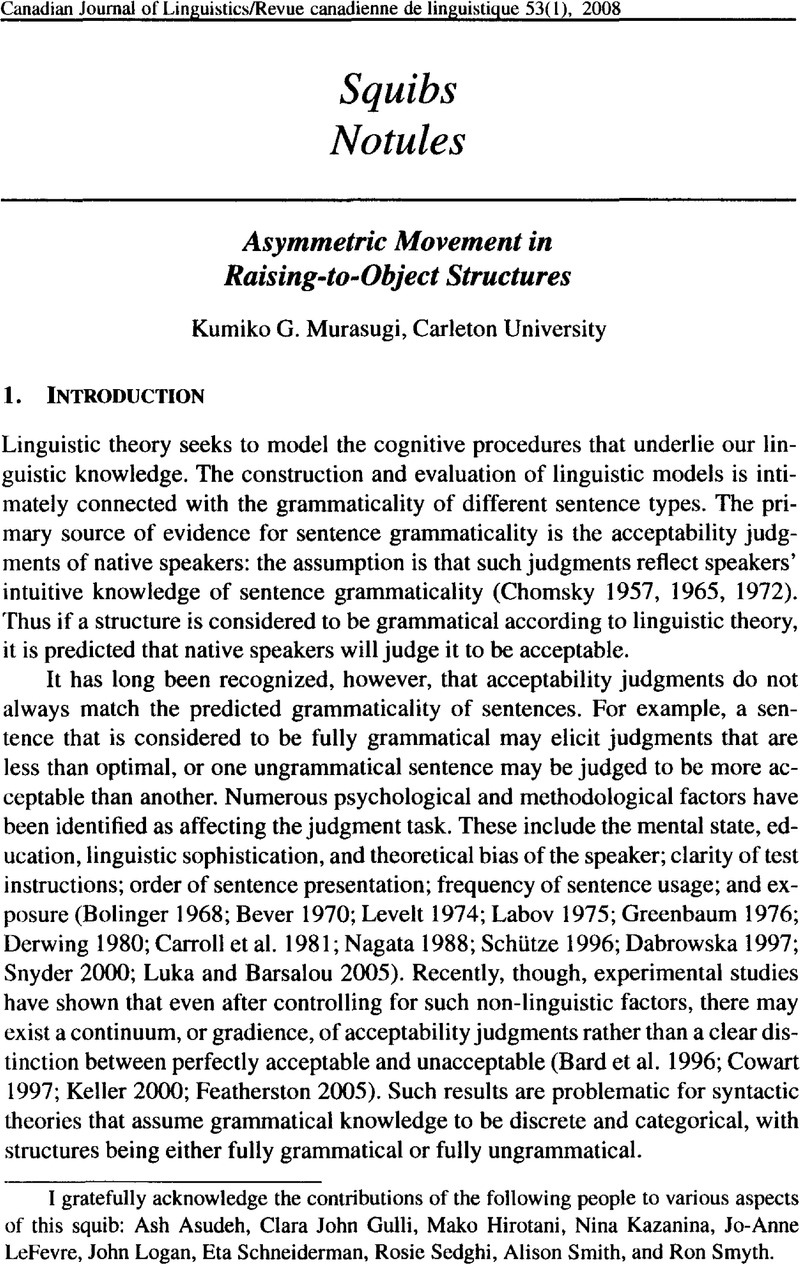No CrossRef data available.
Article contents
Asymmetric Movement in Raising-to-Object Structures
Published online by Cambridge University Press: 27 June 2016
Abstract
An abstract is not available for this content so a preview has been provided. Please use the Get access link above for information on how to access this content.

- Type
- Squibs/Notules
- Information
- Canadian Journal of Linguistics/Revue canadienne de linguistique , Volume 53 , Issue 1 , March 2008 , pp. 85 - 100
- Copyright
- Copyright © Canadian Linguistic Association/Association canadienne de linguistique 2008
References
Bard, Ellen, Gurman, Dan Robertson, and Sorace, Antonella. 1996. Magnitude estimation of linguistic
grammaticality. Language
72:32–68.Google Scholar
Bever, Thomas G.
1970. The cognitive basis for linguistic
structures. In Cognition and the development of
language, ed. Hayes, John R., 279–362. New York:
John Wiley and Sons.Google Scholar
Borkin, A.M.H.
1974. Raising to object position: A study in the
syntax and semantics of clause merging. Doctoral
dissertation, University of
Michigan.Google Scholar
Cardinaletti, Anna, and Guasti, Maria Teresa, eds. 1995. Syntax and semantics
28: Small clauses. San
Diego: Academic
Press.Google Scholar
Carroll, John M., Bever, Thomas G., and Pollack, Chava R.. 1981. The non-uniqueness of linguistic
intuitions. Language
57:368–383.Google Scholar
Chomsky, Noam. 1972. Some empirical issues in the theory
of transformational grammar. In Goals of linguistic
theory, ed. Peters, Stanley, 63–130. Englewood Cliffs,
NJ:
Prentice-Hall.Google Scholar
Chomsky, Noam. 1973. Conditions on
transformations. In A Festschrift for Morris
Halle, ed. Anderson, Stephen and Kiparsky, Paul, 232–286. New York:
Holt, Rinehart, and
Winston.Google Scholar
Chomsky, Noam. 1991. Some notes on economy of derivation
and representation. In Principles and parameters in
comparative grammar, ed. Freidin, Robert, 417–454. Cambridge,
MA: MIT
Press.Google Scholar
Chomsky, Noam. 1993. A Minimalist program for linguistic
theory. In The view from Building 20: Essays in
honor of Sylvain Bromberger, ed. Hale, Kenneth and Keyser, Samuel J., 1–52. Cambridge,
MA: MIT
Press.Google Scholar
Chomsky, Noam, and Howard Lasnik. 1977. Filters and
control. Linguistic Inquiry
8:425–504.Google Scholar
Cowart, Wayne. 1997. Experimental syntax: Applying objective
methods to sentence judgments. Thousand Oaks,
CA: Sage.Google Scholar
Dabrowska, Eva. 1997. The LAD goes to school: A cautionary
tale for nativists. Linguistics
35:735–766.Google Scholar
Dalrymple, Mary, Shieber, S.M., and Pereira, F.. 1991. Ellipsis and higher-order
unification. Linguistics and Philosophy
14:399–452.Google Scholar
Davison, Alice. 1984. Syntactic markedness and the
definition of sentence topic. Language
60:797–846.Google Scholar
Derwing, Bruce L.
1980. Against autonomous
linguistics. In Evidence and argumentation in
linguistics, ed. Perry, T.A., 163–189. Berlin:
Walter de Gruyter.Google Scholar
Featherston, Sam. 2005. Universais and grammaticality: Wh-
constraints in German and English.
Linguistics
43:667–711.Google Scholar
Ferreira, Fernanda, and Henderson, John M.. 1990. Use of verb information in syntactic
parsing: Evidence from eye movements and word-by-word self-paced
reading. Journal of Experiment Psychology: Learning,
Memory, and Cognition
16:555–568.Google Scholar
Francis, W. Nelson, and Kučera, Henry. 1982. Frequency analysis of English usage: Lexicon
and grammar. Boston:
Houghton Mifflin.Google Scholar
Frazier, Lyn, and Rayner, Keith. 1982. Making and correcting errors during
sentence comprehension: Eye movements in the analysis of structurally
ambiguous sentences. Cognitive Psychology
14:178–210.Google Scholar
Hiraiwa, Ken. 2005. Dimensions of symmetry in
syntax. Doctoral dissertation, Massachusetts
Institute of Technology.Google Scholar
Hong, Soo-Min. 2005. “Exceptional”
Case-marking and resultative constructions. Doctoral
dissertation, University of
Maryland.Google Scholar
Keller, Frank. 2000. Gradience in grammar. Doctoral
dissertation, University of
Edinburgh.Google Scholar
Labov, William. 1975. Empirical foundations of linguistic
theory. In The scope of American
linguistics, ed. Austerlitz, Robert, 77–133. Lisse,
Netherlands: Peter de
Ridder.Google Scholar
Lasnik, Howard, and Saito, Mamoru. 1991. On the subject of
infinitives. In Papers from the 27th regional
meeting of the Chicago Linguistic Society, ed. Dobrin, L., Nichols, L., and Rodriguez, R., 324–343. Chicago:
Chicago Linguistic
Society.Google Scholar
Levelt, W.J.M. 1974. Formal grammars in linguistics and
psycholinguistics III : Psycholinguistic
applications.The Hague:
Mouton.Google Scholar
Luka, Barbara J., and Barsalou, Lawrence W.. 2005. Structural facilitation: Mere
exposure effects for grammatical acceptability as evidence for syntactic
priming in comprehension. Journal of Memory and
Language
52:436–459.Google Scholar
Morén, B.
2006. Consonant-vowel interactions in Serbian:
Features, representations and constraint interactions.
Lingua
116:1198–1244.Google Scholar
Müller, Gereon. 1999. Optimality, markedness, and word
order in German. Linguistics
37:777–818.Google Scholar
Nagata, Hiroshi. 1988. The relativity of linguistic
intuition: The effect of repetition on grammaticality
judgments. Journal of Psycholinguistic
Research
17:1–17.Google Scholar
Pickering, Martin J., Traxler, Matthew J., and Crocker, Matthew W.. 2000. Ambiguity resolution in sentence
processing: Evidence against frequency-based accounts.
Journal of Memory and Language
43:447–475.Google Scholar
Postal, Paul. 1974. On raising: One rule of English grammar and
its theoretical implications. Cambridge,
MA: MIT
Press.Google Scholar
Rosenbaum, Peter S.
1967. The grammar of English predicate complement
constructions. Cambridge:
MIT Press.Google Scholar
Ross, John R.
1972. Clause-matiness. Paper read at the Chicago
Linguistic Society, Nov. 31 [sic], 1972. Cited in Borkin
1974.Google Scholar
Runner, Jeffrey. 1995. Noun phrase licensing and
interpretation. Doctoral dissertation,
University of Massachusetts,
Amherst.Google Scholar
Runner, Jeffrey. 2006. Lingering challenges to the
raising-to-object and object-control constructions.
Syntax
9:193–213.Google Scholar
Schiitze, Carson. 1996. The empirical base of linguistics:
Grammaticality judgments and linguistic methodology.
Chicago: University of
Chicago Press.Google Scholar
Snyder, William. 2000. An experimental investigation of
syntactic satiation effects. Linguistic Inquiry
31:575–582.Google Scholar
Sorace, Antonella, and Keller, Frank. 2005. Gradience in linguistic
data. Lingua
115:1497–1524.Google Scholar
Watt, W.C.
1975. The indiscreteness with which impenetrables
are penetrated. Lingua
37:95–128.Google Scholar


